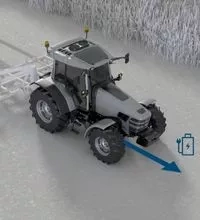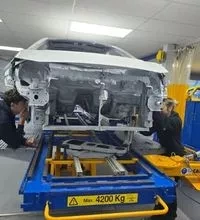Four lessons for automotive from the Paris Air Show
In this article: Range anxiety, battery alternatives, vehicle printing and the surprising return of airships
Ear-cracking fighter jet demos, golf buggies veering between punters, afternoon cocktail receptions – in many ways, this year’s Paris Air Show was much like the last. But while the framework remains the same, exhibits and ideas are at the absolute cutting edge.
Aerospace is traditionally more conservative than automotive, but the decades to come will bring surprises and bold ideas. These four lessons from the show could be transformative for our sector.
Lesson 1: Build a car with the range you need
All-electric flight faces naysayers across the industry, with fingers pointed at batteries’ inferior energy density compared to fossil fuels. Range anxiety becomes a bit more pressing at 30,000 feet.
Australian motor company magniX is determined to make a success of it, however. Its solution, as promoted at the air show: short- and mid-range routes with two small aircraft. One is a converted five-passenger Beaver seaplane with 100 miles range and 100 miles in reserve, while the other is the nine-passenger Eviation Alice, capable of 650 miles with energy in reserve.
CEO Roei Ganzarski is confident of success because of the huge number of flights within those ranges. Electric car manufacturers could also aggressively target short-range routes to find success.
Lesson 2: Batteries aren’t the only alternative power source
Batteries are firmly established as the main alternative to petrol and diesel, but car companies must explore other options as the industry clears up its act. Although questions have been raised over the sustainability of biofuels from plant matter, hydrogen could become an attractive choice if its production becomes more efficient.
Other young technologies could also become viable fossil fuel alternatives – the automotive sector might take inspiration from Boom Supersonic, for example, which used a Paris press conference to announce plans for supersonic flights with Prometheus Fuels. The company reportedly uses renewable energy to convert atmospheric carbon into petrol, diesel and jet fuel.
If it is good enough for supersonic flight, then surely it could handle a trip to the shops.
Lesson 3: Print your vehicle
Boom Supersonic, which aims to bring commercial supersonic flights to the skies, also announced a seven-year partnership extension with Stratasys at the show. The Israeli company’s additive manufacturing expertise could bring major weight benefits for Boom, as well as swift prototyping and customisation.
These properties will become more appealing for automotive in the years to come, making 3D printing an increasingly attractive technology for car development and manufacture.
Lesson 4: Look to the past for inspiration
Between the fighter jets, helicopters, satellites and airliners dotted around the exhibition halls in Paris were stands promoting a surprisingly retro technology – the airship. Concepts included Flying Whales’ cargo blimp for wind turbine transfer and a solar-powered Italian design for high-altitude missions.
The airship was long ago consigned to the history books but now looks set for a comeback thanks to the desire for large-scale infrastructure transfer, long-term aerial missions for surveillance and connectivity, and the pressure of sustainability.
With a rich history of innovation and experimentation, perhaps the automotive sector could also look to the past for solutions to the problems of the future.
Joseph Flaig is deputy editor of Professional Engineering, the official publication of the Institution of Mechanical Engineers (IMechE).




